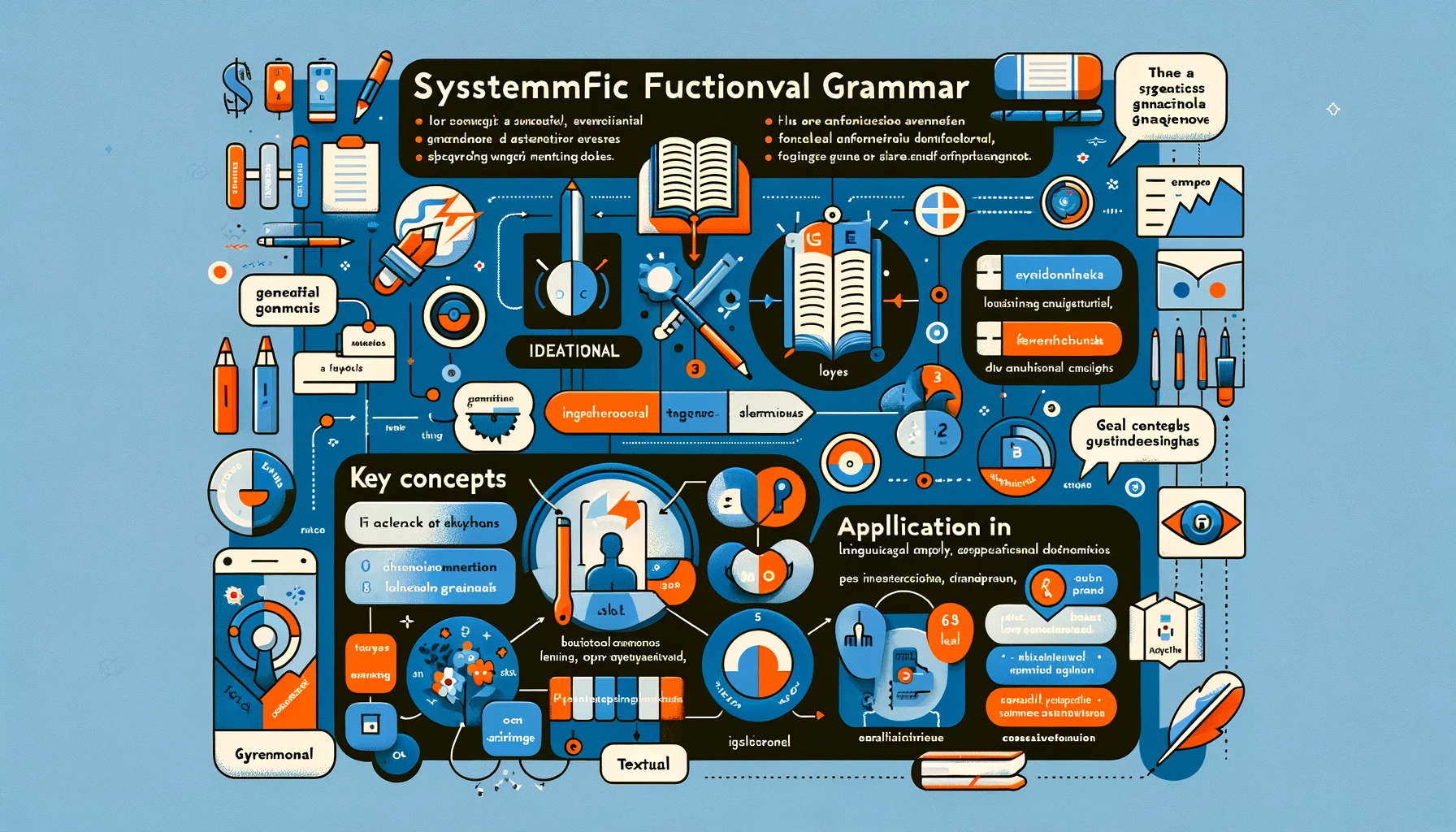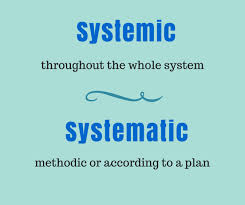Systematic Functional Grammar is a refined model of Halliday’s earlier model of grammar called scale and Category grammar, in which he used a set of four categories unit, structure, class, and rhythm) and four scales rank, exponence, realization and delicacy. Subject, Object’ and ‘Complement’ are the category of structure. ‘Sentence’ and Clause are the (lie instances of the category of unit, verb, noun, etc are the category of class, system is the range of possibilities in a closed choice. For example, the domain of active and passive, affirmative and negative, singular and plural is the domain of system. So scale and category grammar tends to state that all languages have structures, units, classes and systems.

There are, however, different numbers of units in different languages. These units are built up one inside the other. If we start with the sentence, we have five units in English: sentence, clause, group, word and morpheme Sentence. These units have fixed relations between themselves, that is, every sentence consists of one or more than one clause; every „ clause consists of one or more than one group phrase every group consists of one or more than word consists of one or more than morpheme.
If the whole utterance in some context is No. then no’ is one sentence, one clause, one group, one word and one morpheme. These five units are shown separately in the following sentence:
If she comes, she will be welcomed.
We can break it down into all the smaller units in the following manner:
If/she/come=s/she/will=be=welcome=ed
Here the symbol (triple bars shows a sentence boundary, (double bar clause boundary single bar shows group boundary^ space between one element and the other shows morpheme boundary.
Holladay is of the opinion that sentence is not the largest pattern carrying unit in English. It may be paragraph and efforts are being made to analyze paragraph, although no significant progress has been made so far in this respect. Sentence, according to Halliday, is distinct from other units because* if the order of sentence in a text is changed, the text loses its meaning, but if the units below the sentence are re-ordered, we either get an impossible., sentence or the meaning of the sentence is changed For example, if the word order of the sentence—The boy will help girls changed, we may get
a Will the boy help the girl?
b Will the girl help the boy?
The girl help the boy will,
d The boy help the girl will.
The will help boy girl etc.etc.
Since sentence is the unit with which language operates in situation! Halliday calls it lowest non disorder unit. Traditional grammarians treated word as the unit of main interest and early structural linguists focused their attention on morphemes. But the recent tendency is to concentrate on the sentence which is the maximum unit of language, besides the paragraph.
Sometime the units follow one another in simple sequence. For example, the second clause begins when the first ends as in the sentence (1) above. The exponents of this type are called segmental. There are also cases where they occur inside the other or overlap one another. For example, in the word teeth we have two morphemes namely ‘tooth’ plurality;’ but one cannot find in this Case where one ends where the other begins.
This is a case of fusion. When the upper unit becomes a part ‘to the lowest unit we call it a case of rank-shift. For example, a clause becomes a part of group; it is a case of rank-shift. In the sentence ‘the book she gave me is hers’ the clause ‘she gave me’ has been rank shifted and has been to work as a part of the group, and is functioning as a post-head modifier in the structure of the subject noun phrase. Hence, we have an example of rank shift. We should remember at this stage that discontinuity is different from rank-shift. In discontinuity the upper unit does become a part of the lower unit; it only occurs at a remote place in the same hierarchy, e.g. He called Ali up, ‘call’ and up’ are discontinuous elements.
Structure accounts for “the various ways in which an occurrence of one unit may be made up out of occurrence of the unit next below it Sentence structure, in English for Example, is an organization of clause classes structure, for example, is an organization of phrase classes, phrase structure To word classes, and word structure of morpheme classes/ Each element of structure of a unit is said to be realized by a class of the unit next below For example, the element subject’ is realized by the class nominal phrase. Classes are subdivided Into choice classes which constitute systems.
For example, transitive and intransitive active and passive of transitivity and voice respectively. The choices one has at one’s command are not always limitless. When one has only a limited number of possibilities to-choose from, one is in the domain of system. The sets of possibilities in the system are called the terms. For example one can identify a place in a particular structure in English where the only words that can occur are ‘who’, ‘whose’, ‘which’ and ‘what’. In such a condition these four items form a system.
Why Halliday is great at Systematic Functional GRAMMAR
So in the revised version of Halliday’s grammar known as Systemic grammar, the basic concept is that of ‘system* which means ‘a set of options or choices together with an entry condition that If the entry condition is satisfied one option from the set must Be selected.
To each of these options is attached a realization statement showing the mechanism by which _these choices are realized in the language. The grammar itself takes the form of a series of system networks. It has therefore come to be called systemic grammar.
The aim of systemic grammar is not only to demonstrate our actual use of language but also, and importantly, to predict what choices we can make and show to what extent these choices are contextually conditioned. Holliday regards act of speech as a simultaneous selection from among a large number of interrelated options. These options represent the meaning potential’ of language Of such options are generalization or particularly, repetition or addition, a statement or a question etc.
Systemic grammar has two (Components: Systemic and structure) the systemic component ‘details the choices arid combinations of choices possible.The systemic component, in facts the deep grammar of the underlying feature and properties which tend to universal. The structural component shows how these choices are realized. It is the surface grammar of underlying choices. Any one sentence has not got just one structure, but many simultaneous structures all of which are superimposed on one another, as it were. For example, the following sentence may be said to have a number of simultaneous constituents structures:
Bushra has sung a song >
- Transitivity structure ,Actor(Bu3hra)tProcesaw^—
has sung+ Goal a song.
- Mood structure Subject+ Bushra+Predicator
(has sung)+Object(a song)
structure NP!(Bpshra)+VP(has ‘sung)+NP2(a song).
Theme structure: THeme(Bushra)+Theme
‘ (has sung a song).
In the above table, Bushra is at once ‘actor’, ’subject’, ‘NF,‘given’, and ‘theme’. Each of these properties stand for a choice that the speaker had made in the construction of that sentence. The simple sentence (or the clause) may be regarded in most languages as the domain of three principal areas of syntactic choice transitivity, mood, and theme.
We have already hinted the scales of Rank and realization. The scale of delicacy shows how detailed the description is tries to measure the depth of syntactic sub categorization. It tries to draw attention to primary similarity first before directing attention to secondary differences.
Systemic Functional Grammar (SFG), developed by linguist M.A.K. Halliday, is a theory that considers language as a social semiotic system. It focuses on the ways language is used in social contexts, particularly the relationships between the speaker and the listener, and the circumstances of the linguistic exchange. Here’s a basic guide in tabular format to help you understand some key concepts:
| Concept | Explanation |
|---|---|
| Context of Culture | Refers to the broader cultural and social setting in which a text is situated. It influences the genre of the text. |
| Context of Situation | Involves the immediate situation in which a text is produced, including the subject matter, the relationship between speakers, and the mode of communication. |
| Register | Encompasses three variables: Field (what is happening), Tenor (the participants and their relationships), and Mode (the role of language and channel of communication). |
| Metafunctions | – Ideational: Concerned with the content or the “what” of the message. \ |
| Theme and Rheme | – Theme: The element which serves as the point of departure of the message.
| – Rheme: The part of the sentence that provides new information and is the focus of the message. | | Cohesion | Refers to the linguistic elements that connect sentences and clauses, creating a text rather than isolated sentences. Includes reference, substitution, ellipsis, conjunction, and lexical cohesion. |
This table offers a simplified overview of some fundamental concepts in SFG. For a more detailed understanding, it’s recommended to consult academic texts or courses on the subject.
